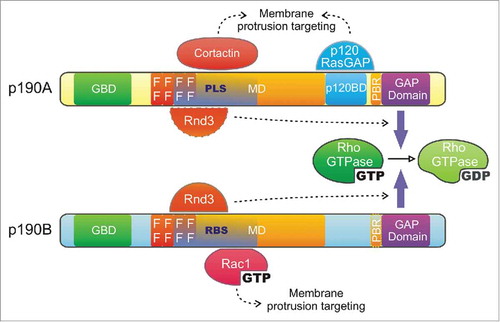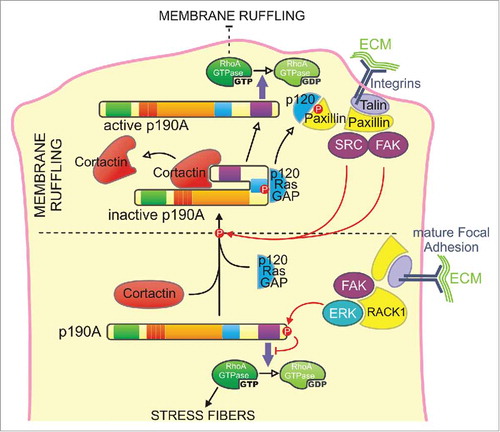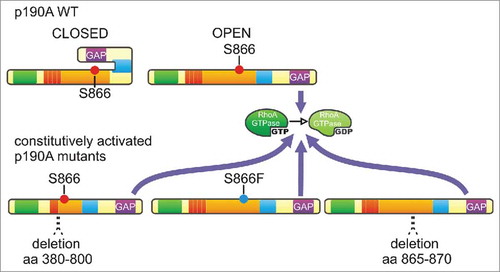Figures & data
Figure 1. p190RhoGAP domain organization - The 2 p190RhoGAP isoforms share a common domain organization. From the N- to the C-terminus, these proteins contain: a GTP-binding domain (GBD), 4 FF motifs (FF), a large middle domain (MD) and a GAP domain (GAP), responsible for their catalytic activity. Binding of cortactin and p120RasGAP to the protrusion localization sequence (PLS) and p120RasGAP binding domain (p120BD) of p190A, respectively, as well as Rac1-GTP to the RBS of p190B targets p190RhoGAP isoforms to membrane protrusions. Rnd3 interaction through the Rac1-GTP binding sequence (RBS) of p190B and presumably the PLS of p190A stimulates their GAP activity toward RhoA. Interaction of the polybasic region (PBR, amino acids 1213–1236) with acidic phospholipids switches p190RhoGAP substrate preference from RhoA to Rac1.

Figure 2. Model for the regulation of p190A targeting and activity at the cell leading edge - Two cooperative mechanisms may control p190A targeting to membrane protrusions. Cortactin binding to the PLS domain constitutively targets p190A in a closed/inactive conformation from the cytoplasm to the leading edge. Cortactin dissociation will result in the opening of the molecule, which locally turns off RhoA, thus allowing the maintenance of the newly expended membrane protrusion. Upon adhesion of the protrusion to the substratum, integrin signaling leads to the phosphorylation of p190A by Src or FAK on its p120BD and subsequent interaction with p120RasGAP (p120) that locally enhances p190A recruitment to the leading edge. p120RasGAP-paxillin interaction thus releases p190A that inactivates RhoA to limit premature adhesion maturation by stress fibers assembly. At the rear of the lamellipodia, recruitment of active ERK by RACK1 to mature focal adhesions induces C-terminal inhibitory phosphorylation of p190A, allowing RhoA to promote the formation of stress fibers.

Figure 3. Auto-inhibition of the GAP activity is lost in p190A mutants - In the model of p190RhoGAP auto-inhibition, wild-type p190A (p190A WT) oscillates between a closed/inactive and an open/active form to ensure intermittent RhoA activity at the leading edge. PLS removal (deletion 380–800) and cancer-occurring point mutation (S866F) and deletion (deletion 865–870) maintain p190A in a constitutively active conformation that leads to enhanced and sustainable RhoA inactivation.

